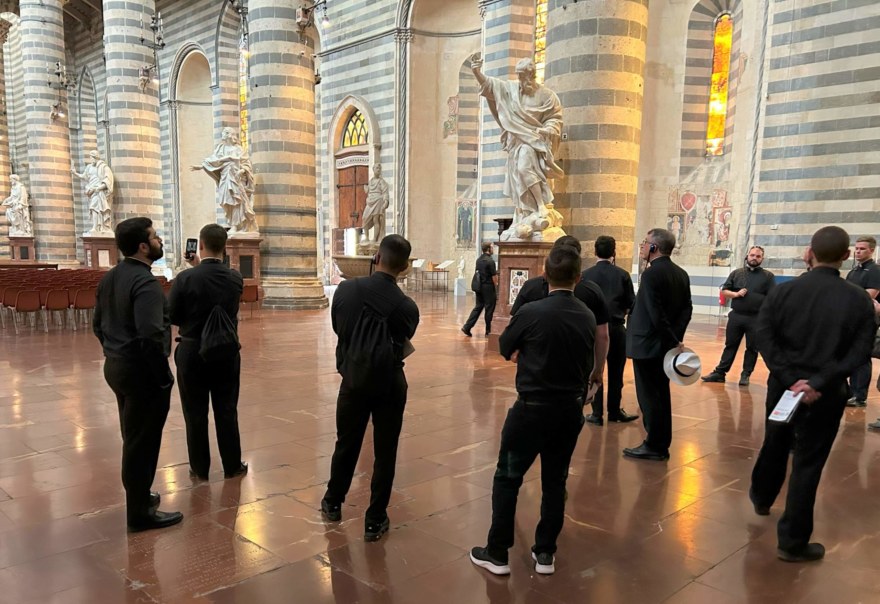Turning the Corner | Postcards from Rome 2023
We look back with David Morand on the highlights of arriving to Italy!
Already there are so many highlights its hard to limit it, but here are the five that most poignantly stick in my mind:
1. Walking into Basilica del Carmine: We arrived in Florence, checked into Casa Santo Nome di Gesu, prayed in the sisters’ little chapel, and had our first true family style Italian meal at Napoleone (as delicious as it was exciting). The following morning, many of us crossed the piazza to the neighboring church – Basilica del Carmine – nondescript stone on the outside makes it appear plain aside from its height, but walking in was a breathtaking experience — seeing for the first time a Florentine basilica. Glorious frescoes in the half barrel ceiling, marble façades on the walls, and an intricate sanctuary. All this, and the Eucharist is exposed on the altar.
2. Entering the main basilicas: On day two in Florence, we got up and went to a daily Mass in the Duomo Santa Maria di Fiori. My breath-taken-away experience at del Carmine turned into jaw-dropping awe from the sheer size. The exterior is a gorgeous alternation of green, white, and red marble. The interior is 45 meters high at the vaults, and 90 at the dome. The dome is an incredible feat of masonry, the interior of which is covered in over an acre of fresco depicting the Last Judgment. After Mass, we returned to part two of our tour, which took us to Basilica di Santa Croce. Of course, another beautiful and massive house of worship, with many beautiful frescos and statues, but also notable is that it is the resting place of Michelangelo, that man of artistic force that would give the Catholic church some of its most impressive, enduring, and stunning works of art. In a completely non-biased way, we saw (amongst many others) an excellent example of this is his famous David sculpture. There is a bronze copy in Piazza della Signora, however we were able to schedule a visit to the Accademia Gallery where the real David is housed. It is yet another moment of turning a corner and being caught off guard by the sight.
3. The people and life of Florence: I am just struck by how charming the city and its people are. Everywhere there are little shops and restaurants, interesting alleyways with cobblestone streets leave you feeling cool in the shade amidst the heat of the day. People walking and visiting with friends, riding bikes or mopeds. There is a certain amount of bustle and street noise, but as you move away from the busy roads, a different atmosphere appears. In the piazzas people are sitting down to an espresso or a glass of wine to visit with friends. People greet each other warmly on their way to work or school, or shopping at the many shops and vendors (ranging from Florentine leather and gold to tourist trinkets and street food). We stopped in one of these restaurants and became acquainted with the owner, Andrea. His welcoming nature, openness to conversation, and general congeniality was basically the personification of the people as a whole. The city has its foundations in the faith, the piazzas and districts have names from Christianity, the streets burst with a desire to tell you their history, and the churches, though more full of museum tourists than the faithful these days, still powerfully demonstrate that it is ultimately for God that these houses of worship were made, without which, Florence would be nothing. It is easy to get caught up in the secular side, but even in the midst of it, we are reminded of why we are on this pilgrimage.
4. Orvieto: We left Florence on Friday, May 26 by charter bus, heading out into the Italian countryside towards Bracciano and Rome. The scenery is incredible, rolling hills punctuated by either individual mountains or small spinal ranges, covered in all sorts of flora: slender Italian Cypress, Cork Oaks, Cluster Pines and Silver Birch, and Olive trees. In the valleys there are sweeping fields of grasses, wheat, and other crops, with little flocks of sheep or the occasional group of cattle. All the time you see towns perched on the hilltops, or nestled in the side of a mountain or valley. One of these is the town of Orvieto, about halfway between Florence and Rome. We drive up the mountain to reach the old city, which is a quaint and serene little town. At the very top sits Cattedrale di Santa Maria Assunta, which is the home of the Eucharistic miracle, a bleeding host, which led to the promulgation of the feast of Corpus Christi. You can see the corporal in which Fr. Peter of Prague wrapped the host to show to Pope Urban IV. The beauty of this church and its significance for the world is bolstered by the commanding views from the top of the city, from which you can see for miles over the valleys.
5. Bracciano: We stayed at the retreat house run by the Nashville Dominican sisters at Bracciano. With a view of the lake, surroundings of nature, and a sleepy neighborhood, the peace is tangible. On our silent retreat, Fr. Eric has given us edifying conferences on the spiritual life such as the necessity of a deep prayer life, how to enter into mental prayer, and the virtues of humility and purity, all with the goal of profound love and intimacy with Jesus. We pray, walk, eat, rest, listen, and as time allows, explore a little. The water of Lake Bracciano, which feeds the northern part of Rome, is clear, cold, and crisp. Dark volcanic sand makes up the bed, drawing the heat from a bright sun in the clear blue sky.
David Morand
Archdiocese of Cincinnati


